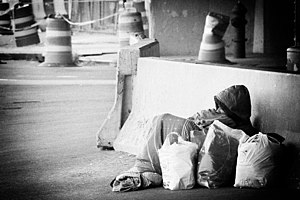
English: Homeless man in New York 2008, Credit Crises. On any given night in USA, anywhere from 700,000 to 2 million people are homeless, according to estimates of the National Law Center on Homelessness and Poverty. (Photo credit: Wikipedia)
Today, in too many communities, a welter of well-intentioned public and nonprofit programs designed to reduce homeless function with competing services and fundraising. This results in unnecessary and unproductive duplication of activities and everyone fighting for the same diminishing dollars.
The National Alliance to End Homelessness (NAEH) offers performance-improvement clinics focused on creating a coordinated plan to reduce homelessness and determine the most appropriate governance structure to implement it.
Too often there is uncoordinated competition among a community’s agencies working in the areas of homelessness prevention, law enforcement, criminal justice, mental health, chemical dependency, hospitals, schools, veterans’ assistance, Medicaid and welfare. When they can all sit down together and work out an overall plan to engage the totality of their services for the same goal, they can save a lot of money and be much more effective, considerable experience has shown,
NAEH’s Center for Capacity Building offers 1.5-day clinics to help communities reduce homelessness and produce better outcomes. The clinics include group discussions, system design and modification planning sessions and presentations on best practices. Participants also receive hands-on technical assistance with data analysis and system assessment before the clinics, as well as follow-up support afterwards.
Jill Fox, Director of Programs and Evaluation for the Virginia Coalition to End Homelessness attended one of these Performance-Improvement Clinics in Richmond and reported:
The room was filled with leaders from private, public, and faith organizations from across the homeless-assistance spectrum. Leaders from local government, Departments of Social Services, mental health and substance abuse services, school-based service organizations, housing developers and homeless service providers all came ready to discuss homelessness in the region. Organizations specializing in populations including victims of domestic violence, veterans, children and families all had a seat at the table.
“When we recognize that no one organization can end a person’s homelessness, we understand that achieving our organizational missions depends on how effectively we work together.
“The data presented for the Richmond region suggested that programs with a ‘housing-first’ approach achieved better permanent housing outcomes and cost less than traditional shelter.
Next month, in the area surrounding Olympia, WA, the housing division of the state Department of Commerce is gathering a number of area agencies in an attempt to replicate the successes realized in other communities that have used these clinics to save money and greatly boost results.
In addition to conducting these clinics, NAEH is working with Congress on a number of pieces of legislation that will help the federal government meet it’s goals of significantly reducing homelessness and completely eliminating veterans’ homelessness within five years.
It wants Congress to provide $2.381 billion for the Homeless Assistance Grants program within HUD in fiscal year 2014 to further invest in proven “housing first’ programs. It also seeks $1.4 billion in the same fiscal year to end veterans’ homelessness by 2019. NAEC wants Congress to invest $75 million for new HUD-VA-supported housing vouchers for 11,000 chronically homeless veterans. Today, nearly half of all homeless veterans reside in California, Texas, New York or Florida.
NAEH also wants the feds to increase access to permanent, affordable housing for extremely low-income individuals and families by modernizing the Mortgage Interest Deduction and using savings to capitalize and fund the National Housing Trust Fund.
It also seeks to:
1) expand the use of innovative and evidence-based family intervention models to support family reunification;
2) build on existing investments in programs serving runaway and homeless youth;
3) improve crisis-response and early intervention approaches;
4) expand the reach and availability of transitional living programs to provide more youth with a stable housing foundation to act as a basis for achieving economic independence; and
5) expand data and research on the nature and extent of homelessness among unaccompanied youth, to improve outcomes for these vulnerable young people.
Related articles














